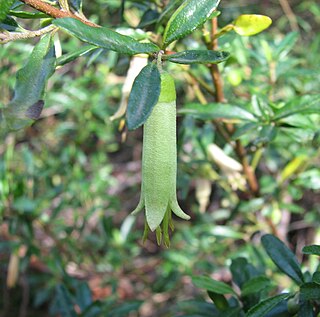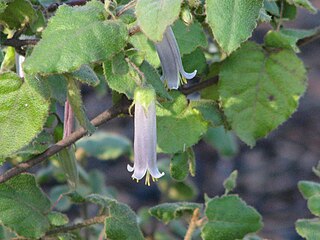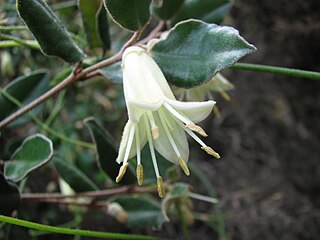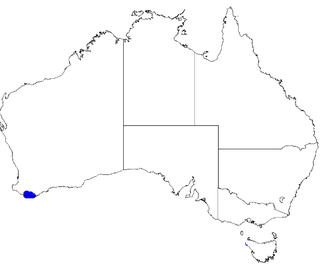
Correa lawrenceana, commonly known as mountain correa, is a species of shrub or small tree of the family Rutaceae and is endemic to Australia. It has elliptical to egg-shaped leaves arranged in opposite pairs and cylindrical, greenish yellow to red flowers usually arranged singly or in groups of up to seven in leaf axils with the stamens protruding beyond the end of the corolla.

Boronia molloyae, commonly called the tall boronia, is a plant in the citrus family that is endemic to coastal regions in the south-west of Western Australia. It is a shrub with pinnate leaves that mostly have between three and seven leaflets, and deep rose pink, four-petalled flowers. It usually grows along streams in sandy soil.

Correa calycina, commonly known as the South Australian green correa or Hindmarsh correa, is a species of tall, dense shrub that is endemic to a small area of South Australia. It has papery, oblong leaves and pendulous green flowers arranged singly on the ends of short side branches.

Correa glabra, commonly known as the rock correa, is a species of tall, erect shrub that is endemic to Australia. It usually has elliptical, mostly glabrous leaves and pendent, pale green to pale yellow flowers arranged singly on short side shoots.

Correa aemula, commonly known as the hairy correa, is a species of shrub that is endemic to south-eastern Australia. It has broadly heart-shaped leaves arranged in opposite pairs, green or greyish green, pendent flowers arranged singly or in pairs and ageing to mauve-purple.

Correa backhouseana is a species of rounded shrub that is endemic to coastal and near-coastal areas of southern Australia. It has elliptical to egg-shaped or round leaves that are densely hairy on the lower surface, and cylindrical to funnel-shaped, cream-coloured to pale green or red and yellow flowers.

Correa decumbens, commonly known as the spreading correa, is a species of prostrate to spreading shrub that is endemic to South Australia. It has narrow oblong to narrow elliptical leaves and narrow cylindrical, pink to red flowers with green lobes.

Correa lawrenceana var. grampiana, commonly known as Grampians mountain-correa, is a variety of Correa lawrenceana that is endemic to Victoria, Australia. It is a shrub with elliptical leaves and cylindrical, velvety flowers covered with matted, woolly cream-coloured to yellowish brown hairs.

Crowea angustifolia is a flowering plant in the family Rutaceae, and is endemic to the south-west of Western Australia. It is an erect shrub growing to 3 m (10 ft) high by 1.0 m (3 ft) in diameter with white or pink flowers in spring.

Boronia virgata is a plant in the citrus family, Rutaceae and is endemic to the south coast of Western Australia. It is a virgate shrub with pinnate leaves with between three and five leaflets, and flowers with red sepals and deep pink, egg-shaped petals.
Asterolasia muricata, commonly known as lemon star-bush, is a species of small, slender, erect shrub that is endemic to South Australia. It has leathery leaves covered with rough points and with the edges rolled under, and yellow flowers arranged singly or in groups of up to three, with woolly star-shaped hairs on the back of the petals.

Asterolasia nivea, commonly known as Bindoon starbush, is a species of weak sub-shrub that is endemic to the southwest of Western Australia. It has leathery oblong to narrow elliptical leaves and white flowers arranged in groups of about three flowers with thick-centred, shield like, star-shaped hairs on the back of the petals.

Correa lawrenceana var. cordifolia, commonly known as the pink mountain-correa, is a variety of Correa lawrenceana and is endemic to south-eastern Australia. It is a shrub with leathery, broadly egg-shaped to heart-shaped leaves, and pink flowers with yellowish tips arranged singly or in groups of two or three in leaf axils.
Correa lawrenceana var. genoensis, commonly known as the Genoa River correa, is a variety of Correa lawrenceana and is endemic to south-eastern Australia. It is a shrub with egg-shaped leaves and yellowish green flowers usually arranged singly in leaf axils.

Correa lawrenceana var. latrobeana is a variety of Correa lawrenceana that is endemic to south-eastern Australia. It is a shrub or small tree with elliptical to egg-shaped leaves and cylindrical, greenish-yellow or reddish-mauve flowers arranged singly or in groups of up to seven in leaf axils or on the ends of branchlets.

Correa lawrenceana var. lawrenceana is the implicit autonym of Correa lawrenceana and is endemic to Tasmania. It is a shrub with papery, oblong leaves and pale green, narrow cylindrical flowers arranged singly on the ends of branchlets.
Correa lawrenceana var. macrocalyx is a variety of Correa lawrenceana and is endemic to New South Wales. It is a shrub with leathery, egg-shaped to broadly egg-shaped leaves, and cylindrical, greenish yellow flowers arranged in leaf axils or on the ends of short branchlets.
Correa lawrenceana var. rosea is a variety of Correa lawrenceana that is endemic to the Snowy Mountains of New South Wales. It is a shrub with narrow elliptical leaves and narrow cylindrical flowers that are pink or dull red with green lobes and covered with small, compact star-shaped hairs.
Diplolaena cinerea, is a species of flowering plant in the family Rutaceae and is endemic to the west coast of Western Australia. It has pale orange flowers, papery, elliptic shaped leaves that are covered in star-shaped hairs on the upper surface.

Diplolaena graniticola, is a species of flowering plant in the family Rutaceae. It is a small shrub with yellow or red pendulous flowers and papery leaves. It is endemic to Western Australia.















